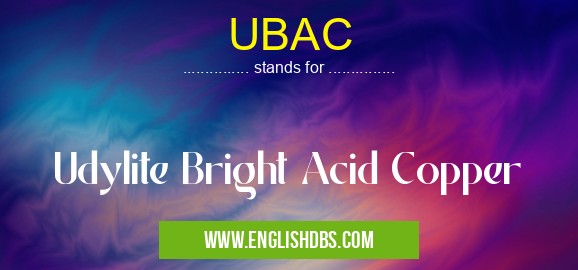What does UBAC mean in CHEMISTRY
UBAC is an abbreviation for Udylite Bright Acid Copper. It is a type of copper electroplating process that produces a bright, shiny finish. UBAC is used in a variety of applications, including decorative plating, electronic plating, and industrial plating.

UBAC meaning in Chemistry in Academic & Science
UBAC mostly used in an acronym Chemistry in Category Academic & Science that means Udylite Bright Acid Copper
Shorthand: UBAC,
Full Form: Udylite Bright Acid Copper
For more information of "Udylite Bright Acid Copper", see the section below.
Process
The UBAC process involves the following steps:
- The metal to be plated is cleaned and prepared.
- The metal is immersed in a copper sulfate solution.
- An electric current is passed through the solution, causing copper to be deposited on the metal.
- The thickness of the copper deposit is controlled by the amount of time that the current is passed through the solution.
Advantages
UBAC has several advantages over other copper electroplating processes. These advantages include:
- Bright, shiny finish: UBAC produces a bright, shiny finish that is ideal for decorative applications.
- Good corrosion resistance: UBAC coatings have good corrosion resistance, which makes them suitable for use in a variety of environments.
- Good electrical conductivity: UBAC coatings have good electrical conductivity, which makes them suitable for use in electronic applications.
- Versatility: UBAC can be used to plate a variety of metals, including steel, brass, and aluminum.
Applications
UBAC is used in a variety of applications, including:
- Decorative plating: UBAC is used to plate jewelry, silverware, and other decorative items.
- Electronic plating: UBAC is used to plate printed circuit boards and other electronic components.
- Industrial plating: UBAC is used to plate tools, dies, and other industrial components.
Conclusion
UBAC is a versatile copper electroplating process that produces a bright, shiny finish. It has good corrosion resistance and electrical conductivity, and it can be used to plate a variety of metals. UBAC is used in a variety of applications, including decorative plating, electronic plating, and industrial plating.
Essential Questions and Answers on Udylite Bright Acid Copper in "SCIENCE»CHEMISTRY"
What is UBAC (Udylite Bright Acid Copper)?
UBAC is an electroplating process used to deposit a thin layer of bright, pure copper on a metal surface. It is widely used in the electronics industry to create conductive pathways on printed circuit boards (PCBs) and other components.
What are the advantages of UBAC over other copper plating processes?
UBAC offers several advantages, including:
- High brightness and reflectivity: The resulting copper deposit has a mirror-like finish, which is desirable for applications such as PCBs and reflectors.
- Good leveling and throwing power: UBAC produces uniform copper deposits even on complex surfaces, ensuring consistent coverage.
- Excellent solderability: The copper surface is highly solderable, ensuring reliable electrical connections.
What is the typical thickness of a UBAC deposit?
The typical thickness of a UBAC deposit ranges from 0.5 to 2 microns (20 to 80 microinches). The thickness can be tailored to the specific application requirements.
What is the chemical composition of the UBAC bath?
The UBAC bath typically contains the following chemicals:
- Copper sulfate
- Sulfuric acid
- Chloride ions
- Brightening agents
- Leveling agents
What is the operating temperature and pH range for UBAC?
The optimal operating temperature for UBAC is between 20°C and 25°C (68°F and 77°F). The pH range is typically maintained between 0.5 and 1.5.
